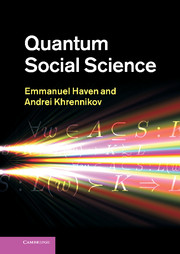Book contents
- Frontmatter
- Dedication
- Contents
- Foreword
- Preface
- Acknowledgements
- List of symbols
- I Physics concepts in social science? A discussion
- II Mathematics and physics preliminaries
- 4 Vector calculus and other mathematical preliminaries
- 5 Basic elements of quantum mechanics
- 6 Basic elements of Bohmian mechanics
- III Quantum probabilistic effects in psychology: basic questions and answers
- IV Other quantum probabilistic effects in economics, finance, and brain sciences
- Glossary of mathematics, physics, and economics/finance terms
- Index
6 - Basic elements of Bohmian mechanics
from II - Mathematics and physics preliminaries
Published online by Cambridge University Press: 05 July 2013
- Frontmatter
- Dedication
- Contents
- Foreword
- Preface
- Acknowledgements
- List of symbols
- I Physics concepts in social science? A discussion
- II Mathematics and physics preliminaries
- 4 Vector calculus and other mathematical preliminaries
- 5 Basic elements of quantum mechanics
- 6 Basic elements of Bohmian mechanics
- III Quantum probabilistic effects in psychology: basic questions and answers
- IV Other quantum probabilistic effects in economics, finance, and brain sciences
- Glossary of mathematics, physics, and economics/finance terms
- Index
Summary
Short introduction to Bohmian mechanics
Sheldon Goldstein in a Foundations of Physics paper [1] indicates (p. 341): “Since macroscopic objects are normally regarded as built out of microscopic constituents …there can be no problem of macroscopic reality per se in Bohmian mechanics.” Goldstein in the same paper remarks (p. 342) that this |ψ|2 has “a status very much the same as that of a thermodynamic equilibrium.”
Basil Hiley the closest collaborator of David Bohm, says the following (Hiley [2] (p. 2)): “What Bohm (1952a; 1952b) did was to show how to retain a description of all the usual properties of a classical world and yet remain completely within the quantum formalism.” The Bohm (1952) [3] [4] references in that quote refer to the original work of Bohm in which he sets out the basics of the Bohmian mechanics.
As we will see later in the next section of this chapter, the appearance of an “additional term” in the Hamilton-Jacobi equation, is the hallmark of Bohmian mechanics and it is very often termed the “quantum potential.” Hiley [2] (p. 2) remarks that since the Bohmian momentum is a well-defined function of position and time, an ensemble of trajectories can be found when the quantum potential is non-zero. A unique, classical path is found when the quantum potential is zero. From the outset, we hope the reader can savor the beauty of this simple but very powerful result. Bohmian mechanics indeed shows this very gentle transition from quantum mechanics to classical mechanics via the value of the quantum potential.
- Type
- Chapter
- Information
- Quantum Social Science , pp. 102 - 110Publisher: Cambridge University PressPrint publication year: 2013



